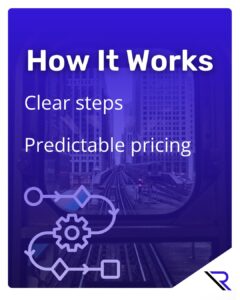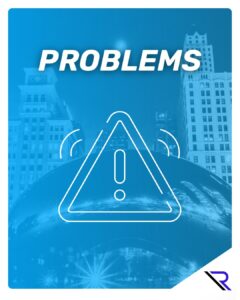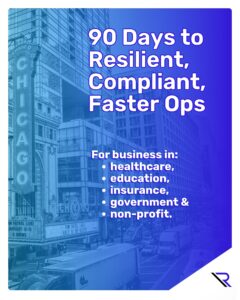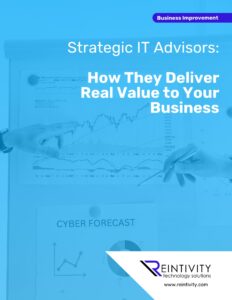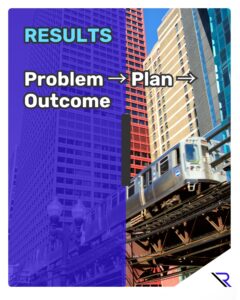
Across Greater Chicago, small and midsized organizations are feeling the same pressure: technology that once kept them moving is now holding them back. Slow systems, scattered tools, and rising cybersecurity risks make even routine tasks harder than they should be.
For leaders focused on community impact—whether it’s educating students, protecting data, delivering care, or running local programs—these challenges come with real consequences. A missed report can delay funding. A network outage can interrupt services. A small security lapse can turn into a compliance crisis overnight.
The good news is that modernization doesn’t have to mean disruption. In just 90 days, most organizations can stabilize their operations, strengthen data protection, and lay the groundwork for long-term growth. The key is to follow a clear, structured roadmap—one that prioritizes outcomes over upgrades and ensures every system change serves your broader mission.
This guide walks through that roadmap step by step. You’ll learn how organizations across the region are modernizing their IT environments without pausing their work, and how you can do the same.
Inside the Modernization Process — Turning Tech Challenges into Momentum
Every organization eventually reaches the same crossroads: systems start lagging, updates become patchwork fixes, and staff find workarounds to keep things moving. What begins as a temporary adjustment becomes a daily burden.
The real issue isn’t the technology itself—it’s the lack of a clear plan for keeping that technology aligned with your goals. Modernization is less about buying new tools and more about bringing order, security, and visibility to the tools you already rely on.
Over time, we’ve found that the most successful organizations approach technology with the same discipline they bring to leadership and finance. They start by identifying three essentials:
The problem worth solving. Not every frustration deserves a project. The goal is to pinpoint what’s slowing you down—whether it’s security gaps, poor integrations, or simple lack of visibility.
- The people involved. The best solutions combine executive vision with frontline insight. Modernization fails when it ignores the people who actually use the systems every day.
- The path forward. Every improvement should serve a measurable business outcome—less downtime, faster reporting, or stronger compliance.
- This approach creates a shift in mindset. Technology stops being a cost of doing business and starts becoming a foundation for growth.
When our team works with organizations across the region, we use a simple leadership model to keep modernization focused and manageable. It’s built around four principles—Clarity, Alignment, Regulation, and Engagement—collectively known as the CARE Framework.
CARE transforms modernization from a reactive project into a proactive process:
- Clarity defines what success looks like.
- Alignment ensures every department moves in the same direction.
- Regulation embeds compliance and security from day one.
- Engagement builds trust and buy-in across the team.
The result is a plan that leaders can communicate easily, track visibly, and measure confidently—without drowning in technical detail.
The 90-Day IT Roadmap — From Reactive to Resilient
Modernization doesn’t have to be overwhelming or open-ended. With the right focus, most organizations can see real progress in the first 90 days.
This roadmap breaks that effort into three clear stages—each building stability, security, and momentum.
Days 0–30 — Stabilize and Assess
The first month is about understanding where you stand.
Audit your existing systems, note recurring issues, and document how outages or slow performance affect your daily operations.
Small changes—like consolidating help-desk tickets or updating key backups—can prevent major disruptions later.
Days 31–60 — Secure and Streamline
Once the foundation is stable, shift attention to protection and efficiency.
Apply critical security patches, update passwords and access policies, and eliminate redundant or outdated applications.
This is also when many teams move files to cloud-based storage and introduce collaboration tools that actually talk to each other.
Days 61–90 — Optimize and Empower
The final phase focuses on building habits that last.
Automate routine reporting, train staff on new workflows, and set performance baselines that can be reviewed quarterly.
The goal isn’t perfection—it’s creating an environment that can adapt quickly without slipping back into chaos.
Across the Greater Chicago area, organizations that follow this 90-day pattern consistently report lower downtime, stronger audit results, and faster decision-making.
They reach that point not by rushing modernization, but by treating it as a leadership exercise—one guided by purpose, measured by results, and executed with calm precision.
Building the Modern Workplace — Technology That Works for People
When teams struggle with slow systems or disconnected tools, it’s rarely a matter of poor effort. It’s a sign that the technology around them hasn’t kept pace with the way they work. In a modern workplace, employees expect the same seamless experience they enjoy in their personal lives—fast, secure, and intuitive.
Too often, organizations respond to new challenges by adding another application instead of improving what they already have. Over time, this patchwork approach leads to frustration, duplicated effort, and data that never quite lines up.
The fix isn’t more software—it’s smarter integration.
Step 1: Simplify the Stack
Begin by auditing what you already use. Identify where tools overlap, what’s underutilized, and where manual steps can be removed. Systems that communicate automatically save time and reduce human error.
Step 2: Automate the Routine
Repetitive administrative tasks drain focus. By automating them—things like onboarding forms, reports, and ticket routing—you free your staff to concentrate on higher-value work. Automation doesn’t replace people; it removes the friction that keeps them from performing at their best.
Step 3: Secure the Experience
A modern workplace is also a secure one. Strong authentication, encrypted communication, and regular training create confidence for everyone who touches your network. When security is simple and reliable, it becomes part of the culture rather than an afterthought.
The result is a work environment where technology supports creativity instead of limiting it. Leaders see clearer data, teams communicate more effectively, and new initiatives launch faster.
Organizations that invest in this kind of alignment find that productivity rises naturally—and retention follows. People want to stay where they can do their best work without fighting the tools meant to help them.
Industry Insights — How Modernization Looks in Practice
Every organization has its own mission, regulations, and constraints. Yet when it comes to technology, the challenges often look remarkably similar: protect data, improve access, and do more with limited resources. The difference lies in what success means inside each environment.
Healthcare
Few sectors depend on information flow as heavily as healthcare. Modern systems must deliver accurate, real-time data while maintaining absolute privacy. Upgrading infrastructure or migrating to the cloud isn’t just about efficiency—it’s about safer care and compliance that holds up under scrutiny.
One regional clinic reduced patient intake times by nearly half after modernizing its records and scheduling system, proving that better technology can directly improve patient experience.
Education
In education, the classroom has expanded beyond the building. Secure collaboration platforms now connect teachers, students, and administrators wherever they are. The focus has shifted from device management to data protection—ensuring student information remains private while learning remains flexible.
Insurance
For insurers, cybersecurity and risk management are inseparable. Modernization means more than digital forms and faster claims—it’s the ability to protect sensitive financial data from constant attack. Streamlined systems also make compliance reviews less disruptive and improve customer confidence.
Government
Public agencies manage vast amounts of citizen data, often with aging systems. Replacing or integrating those platforms strengthens both security and transparency. When information flows smoothly between departments, services become faster, and trust in government technology grows.
Non-Profit
In the nonprofit world, efficiency and trust go hand in hand. Reliable, cloud-based systems reduce administrative overhead and protect donor data, while analytics help leaders demonstrate impact. Modernization ensures that technology serves the mission—not the other way around.
Across all these settings, modernization is less about industry and more about intent. It’s the commitment to run secure, efficient, and adaptable operations that allow every program, service, or policy to reach more people with fewer barriers.
Choosing the Right IT Partner
Modernization rarely succeeds in isolation. Even the most capable internal teams reach a point where outside perspective or specialized expertise becomes essential. The right partner brings structure, speed, and accountability—but finding that fit requires more than comparing service lists or hourly rates.
Think of an IT partner the way you would a strategic advisor: someone who understands your goals, speaks your language, and earns trust by delivering measurable results. The best relationships are built on three fundamentals:
1. Responsiveness
When systems falter, time matters. Look for a partner who can act quickly—both remotely and on-site. Local accessibility can make the difference between a brief interruption and a full day of downtime.
2. Transparency
Good technology management thrives on visibility. Your provider should clearly define what’s being monitored, how progress is reported, and what’s included in service agreements. Clarity prevents surprises and builds long-term confidence.
3. Alignment
An effective partner understands your mission as well as your infrastructure. They connect technical priorities—like security, cloud migration, or automation—to outcomes that matter: continuity, compliance, and efficiency.
Over the years, our team has seen that the most successful collaborations happen when both sides treat modernization as a shared responsibility. The client owns the vision; the partner ensures the path is reliable and repeatable.
Before signing any agreement, ask questions that test both competence and commitment:
- How will you measure success over the next 90 days?
- What is your average response time for critical incidents?
- How do you approach compliance for organizations with regulatory oversight?
- Can you help forecast technology costs over multiple years?
When these conversations feel open and practical, you’ve likely found a partner worth trusting.
The Chicago Advantage and What Comes Next
Technology can be managed from anywhere, but transformation happens faster when help is close to home. Local expertise matters—not just for faster response times, but for understanding the region’s regulatory landscape, infrastructure realities, and business rhythms.
Across the greater metro area, organizations that modernize with local partners gain something larger than convenience. They gain context. The people designing their systems know the challenges of balancing state compliance with limited budgets, or of keeping hybrid teams productive across city and suburban sites. That shared understanding shortens every project timeline and strengthens every solution.
The next step toward modernization isn’t a major overhaul—it’s a conversation.
Start by reviewing what’s working, what’s slowing you down, and what risks you can no longer afford to carry forward. From there, build your 90-day roadmap: stabilize, secure, and optimize.
Once that foundation is in place, growth follows naturally. Systems stay aligned with strategy. Teams stay connected. And downtime, once a constant worry, becomes a rarity.
Modernization isn’t about chasing technology trends. It’s about protecting your mission, empowering your people, and creating an organization that adapts as quickly as the world around it.
When your systems are steady, your data secure, and your staff confident, your focus returns to what matters most—the work that keeps this region moving forward.
Ready to see what your roadmap looks like?
Schedule your complimentary IT assessment with us today.


